Blog
Archives
.
. . from 2012 to current
THURSDAY
JULY 30 - 2015
Portsdown
Hill
Jean and I had
a very pleasant walk this morning on Portsdown Hill
around Fort Widley. We parked in the main observation
area where we had a coffee and a cake from Mick's
Burger Bar. Note, the cakes are home made and very
good too! We are so lucky to live close to such a
magnificent wildlife area with magnificent views over
Portsmouth and the Solent to the Isle of Wight. This
photo shows the large building of QA Hospital at the
bottom of the hill.
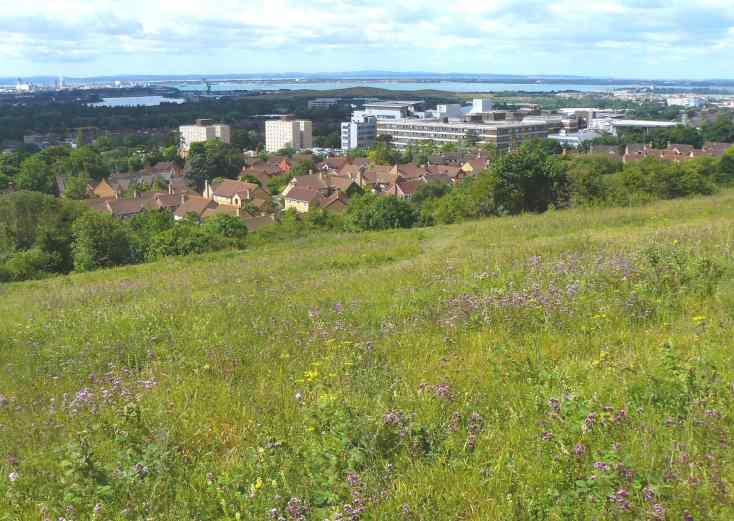
We walked along the
lower path beneath the main road and then back behind
the fort. The wild flowers along the lower path below
the fort were colourful mixture of purple and yellow
with Wild Marjoram, Field Scabious, Wild Parsnip and
Agrimony dominating. I don't recall having seen quite
so much Scabious before. Other flowers I noted
included Rough Hawkbit, Common Ragwort, Greater
Knapweed, Eyebright, Harebells, Wild Basil, Agrimony,
Hemp Agrimony, Rosebay Willowherb, Yellow Wort,
Nettle-leaved Bellflower. No sign of any orchids - all
gone to seed.
Here
is a selection of photos from the hill:
Nettle-leaved Bellflower (north of the fort), Peacock
on Marjoram,
Field Scabious and Eyebright
Emsworth
Harbour
Following
Peter Milinets-Raby's report of the return of the
first Black-tailed Godwits to Emsworth Harbour on
Tuesday (28 July) I decided to pay my first visit of
the new season to check them out from my favourite
position on the Thorney seawall. I was there from
about 3pm to 4pm during which the tide was falling
quickly from high water at 11.30am. The weather was
fine with light cloud which was good for viewing and
digiscoping.
The Godwits arrived in two groups. First to arrive
were two Godwits that fed closely together, one of
which was colour-ringed with the combination B+GN
(left leg: blue with red on the ankle; right leg green
over black). Note, the right leg ring looks blue in
the photo, but it was definitely green. I have no
previous records for this bird and will check with
Pete Potts as to when and where it was ringed.
A much larger group of
24 godwits in various stages of moulting summer
plumage arrived a few minutes later. They included
just one colour-ringed bird: G+RW. This is the
very regular Emsworth wintering godwit since Nov 2008
and was first seen this autumn season by Peter
Milinets-Raby on July 28th.
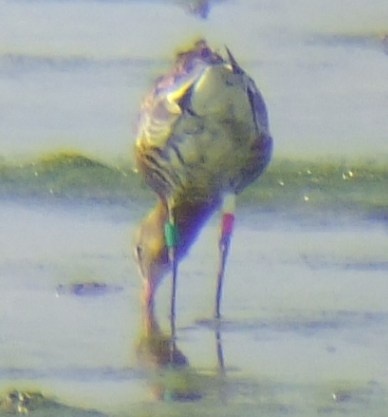
Brook
Meadow
Malcolm
Phillips got some interesting photos on Brook Meadow
today, including this shot of what I think is a
female Beautiful Demoiselle ovipositing.

Malcolm also got
photos of a couple of Meadow Grasshoppers with
very different colouring. The short wings on both
insects provide the best clue to their species.
Malcolm also got this
shot of a female Long-winged Conehead which is
similar to the Short-winged Conehead but for its
longer wings and long ovipositor which is sometimes
brown as in this photo. Finally, Malcolm spotted this
tiny colourful moth called Pyrausta
aurata or Mint Moth which can be seen flying
during the day in gardens.
Malcolm tells me he
also saw a Kingfisher for the first time since
before his holiday but the bird was to quick for him
to get a photo. It was in the tree in the middle of
the stream as you look south off the footbridge at the
top of Peter Pond.
Mystery
wasp
Regarding the
mystery insect with the orange abdomen that I
photographed on Brook Meadow yesterday, both Ralph
Hollins and Chris Oakley agreed that it was a Rose
Sawfly.
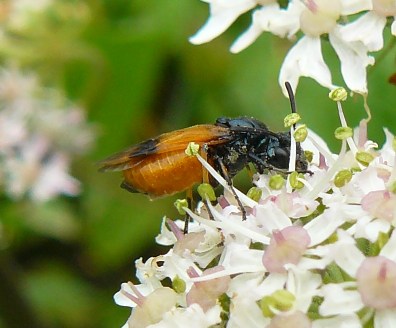
Chris added "They are
the bane of my life as the caterpillars can strip a
rose bush of its leaves in a few days. If disturbed
the caterpillars drop to the ground where they are
almost invisible. Yours appears to be a female because
of the dark spot at the base of the abdomen. They get
their name from the females ovipositor that is shaped
like a saw, which it uses to cut into a plant stem
where it lays its eggs."
WEDNESDAY
JULY 29 - 2015
Brook
Meadow
I had a stroll
down the main river path this morning, inspecting the
Hogweed flower heads as I went. In addition to the
regular Red Soldier Beetles and (male) Common Wasps, I
found several hoverflies and some yellow and black
Longhorn Beetles (Strangalia maculata)
which seem particularly common this year.

Other insects included
what looks like a Soldier Fly - possibly
Stratiomys chameleon (Chinery p.198) and
a small insect with a rounded orange abdomen and black
thorax that I do not recall having seen before.
Possible Ruby-tailed Wasp?
Peter
Pond
I met Malcolm
Phillips who was standing on the Lumley Path
footbridge watching several small birds which were
constantly flitting across the channel through the
reedbeds at the north of Peter Pond. We watched them
together for about 20 minutes and concluded they were
most likely to be a small family of Reed Warblers.
This was confirmed by Malcolm's photos. The bird on
the left is an adult Reed Warbler and I think the one
on the right is a young Reed Warbler.
TUESDAY
JULY 28 - 2015
Brook
Meadow
During my walk
around the meadow this afternoon, I noted several
plants in flower to add to the Brook Meadow 2015 list.
They included Balm, Purple Toadflax, Guernsey
Fleabane, Wild Angelica and Prickly Lettuce. There are
also a couple of Hollyhocks that are flowering on the
edge of Palmer's Road Car Park.
The rampant growth of Great Willowherb on the
south meadow reminds me of what Brook Meadow used to
look like before the conservation group took over in
year 2000.
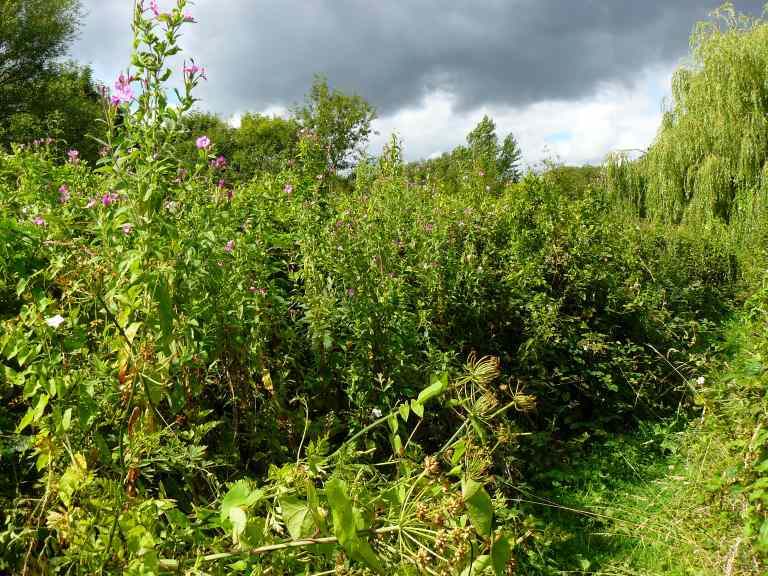
The small pink flowers
of this large plant are now at their best
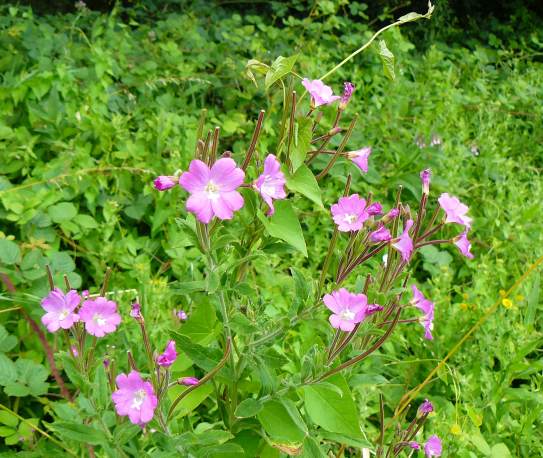
Marsh Woundwort
is now in full flower, with at least 30 flower spikes
showing well and attracting insects, at the north end
of the Bramble path through the south meadow.

The Lumley area is now
carpeted with the bright yellow flowers of Common
Fleabane, broken here and there by the red of Common
Knapweed.
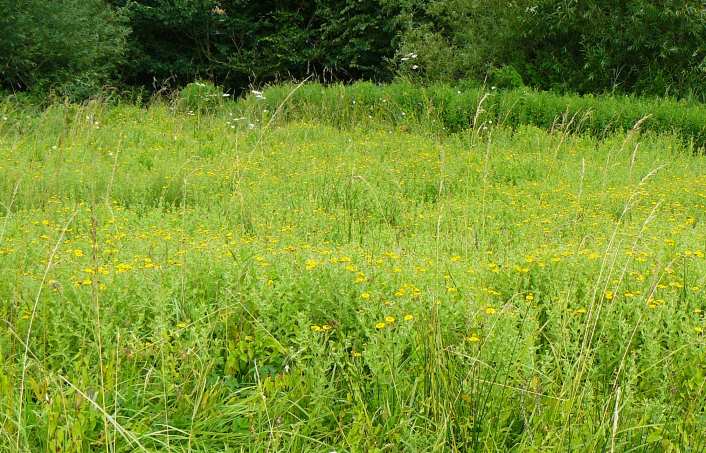
Walking through the
area one also finds Red Bartsia and the tall spikes of
Sharp-flowered Rush.

Just one Wild
Angelica is flower on the Lumley area, a more
rounded flower head than Hogweed and even more
attractive to red Soldier Beetles.

There is no sign of
flowers on the Pepper-saxifrage as yet, though Ralph
Hollins has seen it in flower in Havant.
A very bright
Comma perched briefly for a photo on the
Bramble path; it could be a hutchinsoni
which is brighter and more golden than the regular
Comma and emerges in the summer brood. I spotted the
dark underwings of a Peacock butterfly
contrasting sharply with the yellow of a Common
Fleabane flower.
I spotted a hairy fly
stumbling around on a Hogweed flower head. This could
be same mystery fly that I presented on the blog on
July 25th and which has evaded identification. Today's
fly is on the left and the previous mystery fly is on
the right.
Emsworth
to Langstone
Peter
Milinets-Raby walked from Emsworth to Langstone on a
very cold and windy morning that felt like autumn!
Emsworth Harbour from 6:10am: 9 Black-tailed Godwit
(three with rings O//R+WW//- and G//R+BY//- and
G//R+WR//- These three have not been seen by me
before!?!?) - See
Brian's comments
below.
Mostly in summer plumage, 1 Whimbrel, 7 Redshank, 1
Lesser Black-backed Gull, 9 Turnstone (in fine summer
plumage), 4 Common Tern.
Emsworth Mill Pond: Mute Swan family.
Beacon Square from 6:28am: 13 Mute Swans - slowly
drifted towards Nore Barn, 17 Redshank.
Nore Barn from 6:37am: 8 Redshank, 24 Black-tailed
Godwit (most in summer plumage), 2 adult Lesser
Black-backed Gulls with 3 very noisy and freshly
fledged juvs, 1 Whimbrel, Greenshank in the stream
with colour rings G//R+GL//- One of the regulars
returns!! - See
Brian's comments
below.
7 Sand Martin flew low west.
Conigar Point from 7:03am: 2 Stock Dove, 1 Lesser
black-backed Gull,
Pook Lane from 7:15am: 8 Greenshank (N//R+RY//- and
RG//-+YY//- and B//R+GR//- and G//R+LG//- The first
was seen the other day. YY is a regular and surprise
surprise, I have not seen the other two!?). 2
Whimbrel, 19 Swallow mobbing Sparrowhawk, 73 Redshank
(-/B+B//YL),
Juvenile Peregrine tried to catch a Greenshank, but
failed as the Greenshank spectacularly ditched into
shallow water, 3 Turnstone (in summer), 1 Great
Crested Grebe, 1 Common Tern, Juvenile Mediterranean
Gull (see photos).
Langstone Mill Pond from 8am: 1 Swift over, 1 Stock
Dove, No swans!
On
the left juvenile Med Gull with juvenile Black-headed
Gull for comparison. On the right juv Med Gull
Brian's
comments on the colour-ringed Black-tailed
Godwits
G+BY - There have been only four previous sightings in
Emsworth since 23-Nov-10.
G+WR - Ringed at Farlington Marshes on 10Sept08 as
adult male. It has been a very regular wintering bird
in Emsworth since then with 112 sightings.
O+WW - No records at all for this bird. Could it have
been O+WL which has been seen in Emsworth over the
past two autumns.
Note
on colour-ringed Greenshank G+GL
Greenshank
G+GL was ringed on 22-Sep-2014. This was almost
certainly the same bird that had been a regular
feeding companion to the Spotted Redshank at Nore
Barn. It was subsequently seen feeding with the
Spotted Redshank in the Nore Barn stream. Good to see
it is back 'home'. Now we await the arrival (fingers
crossed) of the Spotted Redshank for its 12th winter
running.
Hedgehog
in garden
Caroline
French is pleased to say that a Hedgehog has taken up
residence in the Hedgehog box in her North Emsworth
garden. She has also seen two small Hedgehogs which
maybe young from earlier this year and which are
gradually becoming more independent and dispersing.
The presence of the female has attracted the
attentions of a male and last night Caroline saw them
mating. She assumes it is the female which has moved
into the box - perhaps the two young are still with
her. She has been putting out saucers of mealworms,
peanut pieces, raisins and suet pellets and last night
all four hogs were together around the food.
Late news: Caroline informed me that last night she
had six Hedgehogs, not including the large male. So
seven individuals over two nights of which five would
have been born this year. Amazing!
Godwits
return
Ralph Hollins
notes that 7 Islandic Black-tailed Godwits were
reported in the Scilly Isles on July 7, the first sign
of 'our birds' arriving back in the south after their
breeding season. Ralph thinks there should be quite a
few back in Hampshire by now, though the birds in the
Scillies may have been early returning failed
breeders. And he is right judging from Peter
Milinets-Raby's report from this morning.
MONDAY
JULY 27 - 2015
Waysides
News
Jane Brook and
I carried out a survey of the plants on the
Warblington Underpass wayside this morning. We managed
to park outside the swing gate despite the presence of
construction vehicles on the site. The central verge
leading to the underpass had recently been mown, so
there was no chance of any flowers there. However, the
southern verge was untouched and this is where we
concentrated on.
There was a good show of many late flowering plants,
such as, Common Knapweed, Common Ragwort and Stone
Parsley. A good selection of plants was found at the
western end of the main verge and also round the
corner towards the metal gates. We logged a total of
85 plants including a number which were new to this
wayside list; ie, Common Fumitory, Spear-leaved
Orache, White Campion, Common Poppy, Lesser Hawkbit,
Lesser Swine-cress, Fool's Parsley and Common Couch,
Creeping Bent-grass and Pale Persicaria (identity
confirmed by the numerous tiny short-stalked glands on
the upper stem and flower stalks). We were also
pleased to find a good flowering of
Burnet-saxifrage (while-flowered umbellifer
with no bracts) at the western end of the wayside
close to the new wooden fence.
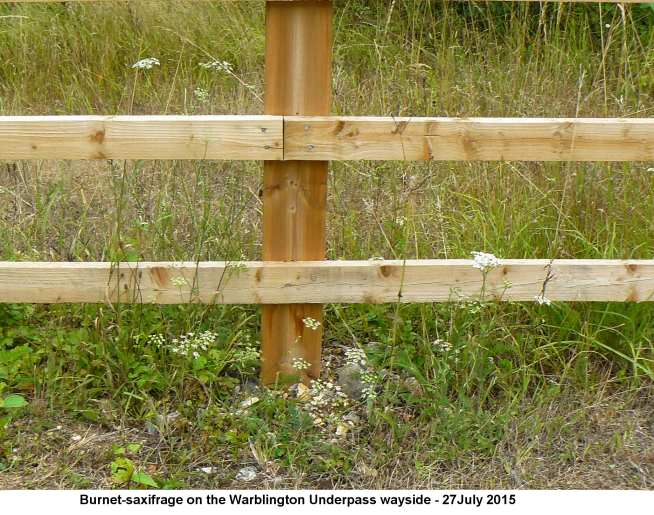
After finishing at
Warblington we came back to Bridge Road to carry out a
litter pick of the wayside. We filled one bag with
rubbish and picked up an astonishing 12 full bottles
of Vodka. Who on earth is consuming all this alcohol?
And then driving?
Brook
Meadow
Malcolm
Phillips had a good day for butterflies on the meadow
today so made a collage of them for us. There's a
challenge to identify them all.
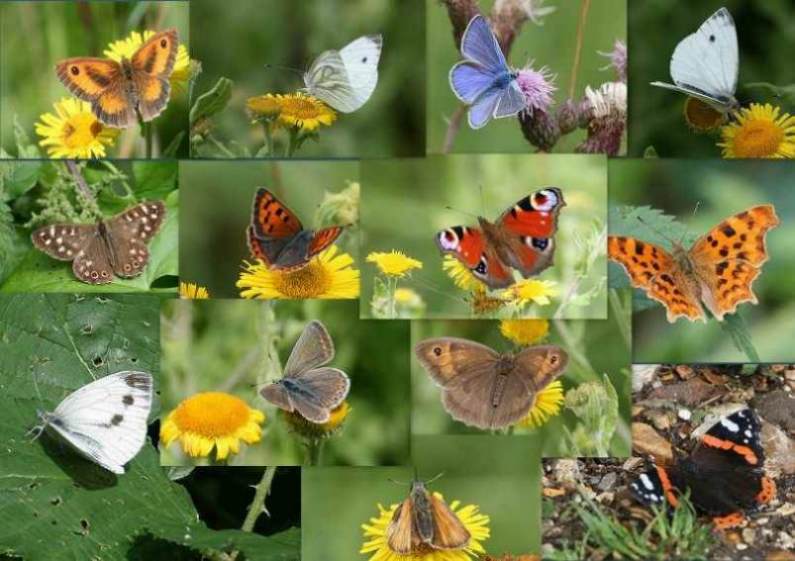
He also came across a
Slow Worm all curled up in the north meadow.
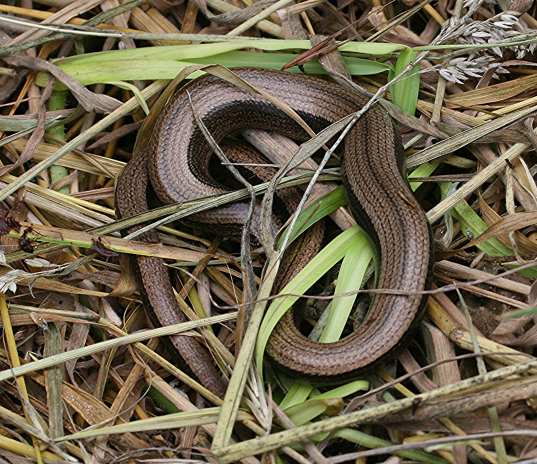
Malcolm got a brief
glimpse of a deer as it ran out of the trees at the
top of the centre meadow and into the trees near the
S-bend. No photos, but most likely a stray Roe Deer.
SATURDAY
JULY 25 - 2015
Brook
Meadow
I had a very
pleasant stroll around Brook Meadow this afternoon in
warm sunshine. The main feature of interest on the
wildlife front were the insects feeding mostly on the
large white flower heads of Hogweed. Red Soldier
Beetles were, as expected, the dominant species
feeding, mating or just generally lounging around. The
were also a good number of Common Wasps feeding
on the Hogweed. These will probably be males which
appear in late summer to feed on flowers. They have
longer antennae than the female workers.
The Hogweed flowers
were also a popular feeding site for a variety of
other insects, including Oedemera
nobilis - I think the photo on the left shows
a female without the swollen thighs of the male. There
were also many flies, including this Flesh Fly
on the right. .
There were also
several species of hoverflies including what I thought
at first was the familiar Syrphus
ribesii (on the left).
However, Tony Davis kindly corrected me to say it was
in fact Myathropa florea - see Chinery's
Insect Guide p.206. Tony added that most photos of
species in the genus Syrphus will not be
identifiable to species.
One I think I must have got right was Scaeva
pyrastri (on the right) - with pale lunules on
the abdomen, white or cream.
Also, on the Hogweed
were Episyrphus balteatus (Marmalade
Fly) and

Here are another two I
have not yet been able to identify. Chris Oakley says
the Ichneumon fly on the left is a male Pimpla
rufipes. A female would have a long
ovipositor. For more details see . . .
http://www.naturespot.org.uk/species/pimpla-rufipes
The Cinnabar
caterpillars are widespread on the Hoary Ragwort
plants on the main orchid area on the north meadow and
in far greater numbers than I recall in previous
years. The Ragwort is not yet in flower.
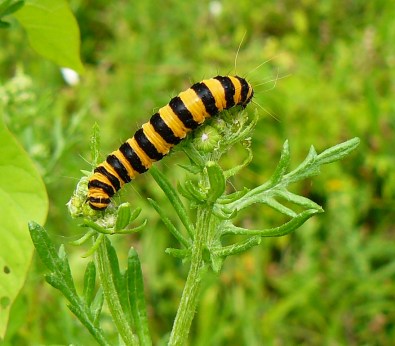
Butterflies seen
during my walk included Comma, Red Admiral, Speckled
Wood, Meadow Brown, Gatekeeper and Small Skipper.
Malcolm Phillips was also on the meadow this afternoon
(we did not meet) and got a fine male Common
Blue along with our first male Common
Darter of the year - on its favourite perching
spot on the south bridge.
He also spotted this
female Blackcap peeping out of the bushes. I
hope she has successfully bred on the meadow this
year.
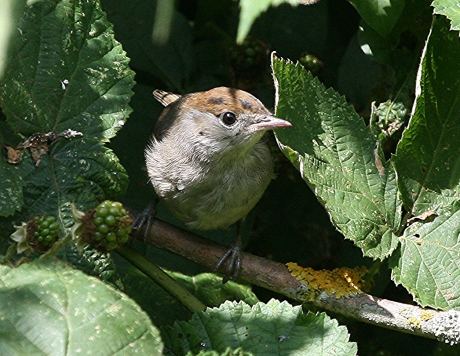
Francis Kinsella had a good day for butterflies on
Brook Meadow. He saw Comma, Peacock, Red Admiral,
Large White, Green Veined White, Gatekeeper, Meadow
Brown, Speckled Wood, Holly Blue and Common Blue.
Walking back north through the cow field toward
Westbourne he saw lots and lots of second brood
Holly Blues along the Hedgerow. They seem yo be
doing very well here as they were earlier in the year.
I went to Hollybank Woods to look for White Admiral
but did not see any, I did spot a Hummingbird Hawk
Moth though just as it was getting a bit
darker.
Mystery
fly
Ralph Hollins
has had another stab at the one of the mystery flies
that Malcolm Phillips photographed on Brook Meadow.
Ralph thinks it is Cheilosia illustrata
see . . . http://www.diptera.info/forum/attachments/dsc_6382.jpg
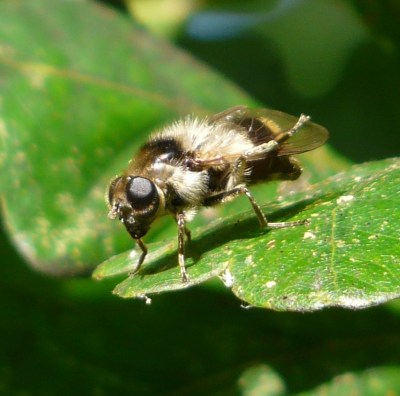
However, Tony Davis
disagrees. He does not believe Cheilosia illustrata
is identifiable from that photo. So, the mystery
remains unsolved. Let's see if Malcolm can get a
better picture of the creature.
FRIDAY
JULY 24 - 2015
Redshank
return
Peter
Milinets-Raby recorded the first of the returning
Redshank yesterday at Langstone where he counted 80 on
the shore. These birds are probably early birds from
their breeding grounds in the North of England or
Scotland, or even Scandinavia. Redshanks are
increasingly scarce breeding birds in the south of
England.
Two of Peter's Redshanks had colour rings with the
combinations B+B/GL and B+B/YG - both not recorded
before by him.
Last evening, my neighbour, Rob Foord sent me a photo
of another colour-ringed Redshank that he took
yesterday while walking along the foreshore at
Emsworth.
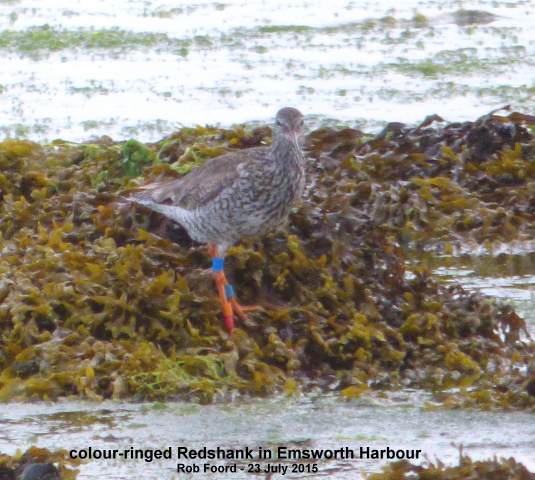
The combination of
rings of this bird was B+B/OR which looks like a
regular Emsworth wintering Redshank as it was also
seen and photographed in Emsworth by Malcolm Phillips
on 14-Dec-14. All these Redshanks were caught and
ringed by Pete Potts and his team at Thorney Island on
Saturday 13 Sept 2014.
Note: All colour-ringed Redshank sightings should be
sent to Josh Nightingale the Redshank recorder at . .
. frg.sightings@gmail.com
Hampshire
Farm
Chris Oakley
has his Hampshire Farm web site up and running again
with a regular blog.
So for all the news from the farm go to . . .
http://hampshire-farm-meadows.simplesite.com/
BTO
information pages
The BTO has
many useful pages on its web site for the
identification and understanding of birds. One
concerns how to identify young birds which are often
very different from their parents. See . . .
http://www.bto.org/volunteer-surveys/gbw/gardens-wildlife/garden-birds/behaviour/identifying-young-birds?dm_i=NXK,3JDMV,3UEDCR,COPV0,0
Another BTO page
involves plumage abnormalities. From time to time we
come across a bird with plumage that is different from
the norm for a species. Some of these abnormalities
may result from abnormal feather growth or feather
loss, while others may be a consequence of problems
with pigmentation. The leucistic Blackbird is a common
aberration.
See . . . http://www.bto.org/volunteer-surveys/gbw/gardens-wildlife/garden-birds/behaviour/plumage
THURSDAY
JULY 23 - 2015
Hampshire
Farm
Chris Oakley
has been looking at the insects on Hampshire Farm and
has amassed dozens of photographs, many of which he
still has to identify. He finds the wasps, sawflies
and hoverflies are the most difficult, as there are so
many varieties.
Some of the Common Ragwort is playing host to the
Cinnabar moth caterpillars. Chris has also seen a
Clouded Yellow butterfly and many Six-spot Burnet
moths on the farm. He also managed to get himself
bitten by a spider and stung by a wasp, so tread
warily when you visit the farm!
A Mallard has managed to raise a family again this
year; six young have been seen, quite well grown, but
there may be others in the reed beds. There is also a
very young Black-headed gull in brown plumage.

Langstone
Mill Pond
Peter
Milinets-Raby had 40 minutes spare today, so he popped
down Langstone Mill Pond ahead of the tide pushing in
to hide tide (2:30pm to 3:10pm). He had good views of
the Tufted Duck female with her two ducklings (usually
so elusive, no a nice change).
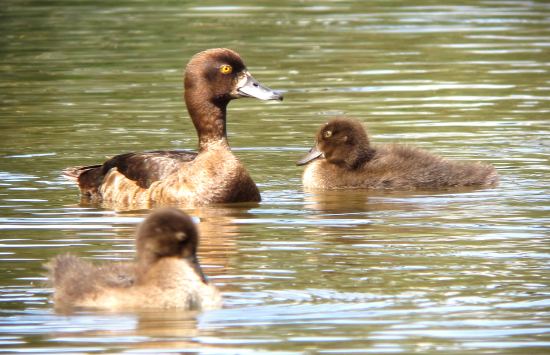
Mute Swan family plus
6 cygnets, being fed bread by load of children. Reed
Warbler - One still singing and birds seen dashing
across the pond. Off shore: 3 Greenshank, 80 Redshank
(two with colour rings -/B+B/GL and -/B+B/YG - both
not recorded before)
Mystery
flies
I think we
have successfully cracked one of the mystery flies
that Malcolm Phillips photographed on Brook Meadow -
see yesterday's blog.
However, the identity of the other one remains in
doubt. Ralph Hollins thought it might be a hoverfly
called Leucozona lucorum, but Tony Davis
says "No, it is definitely not lucorum!" So, I
think that one will remain a mystery until Malcolm
gets a better photo.

WEDNESDAY
JULY 22 - 2015
Fort
Cumberland
I had to go
into Portsmouth this morning, so took the opportunity
to have a walk around the Fort Cumberland Open Space
(SINC) at Eastney. I have been there many times over
the years and it can be very rewarding in spring and
summer for its special flowers. It is the largest area
of natural coastal heathland in Portsmouth which
developed on a large stable shingle bank. If you have
not been there it is easy to find. Go along the road
towards Eastney Ferry and it is on the right just
before you get to the military fort.
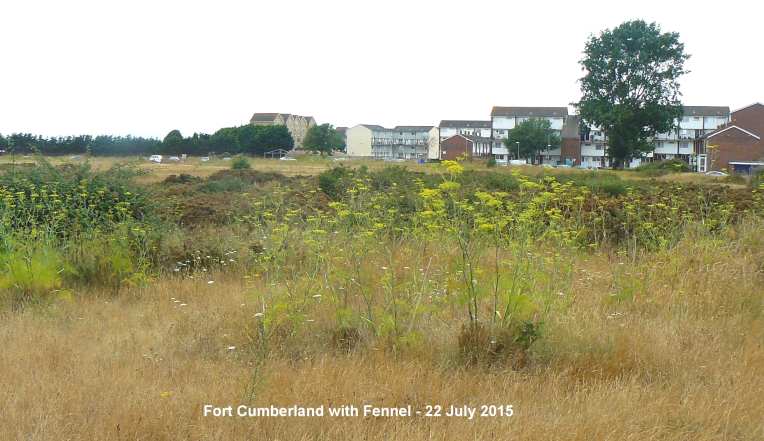
Fennel (as
shown in the above photo) is one of the most common
plants on this site, but one has to see it in full
flower, as it was today, to appreciate its true beauty
as in the following photo.

Fennel was one of the
plants introduced by the Romans which is still going
strong. Alexanders is another that comes to mind. It
is grown in gardens and does escape, however, like
Alexanders, it is now well naturalised particularly in
areas like this near the sea. The leaves smell
strongly of aniseed when crushed. It is also a good
nectar source for Bumblebees, like this Bombus
terrestris.
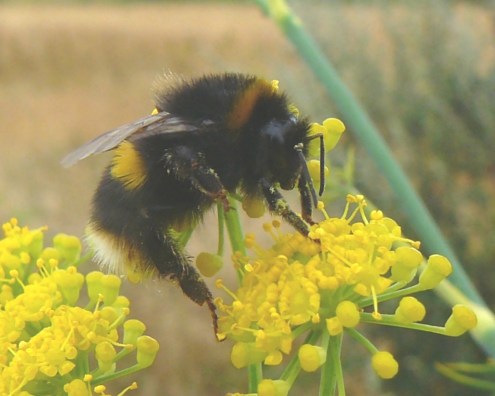
Wild Radish is
another distinctive plant of this site. Its flowers
can be either white or yellow, though they have pretty
well gone over now. However, lots of seed pods divided
into several 'beads' were on show. I recall a tip from
F Rose (Wild Flower Key) that the beaded joints of the
pods of Wild Radish are weak and break apart easily
when ripe.

In contrast the pods
of Sea Radish are stronger and do not break easily. I
also found a good number of pods with a single rounded
bead which I am not sure about. Can anyone help?
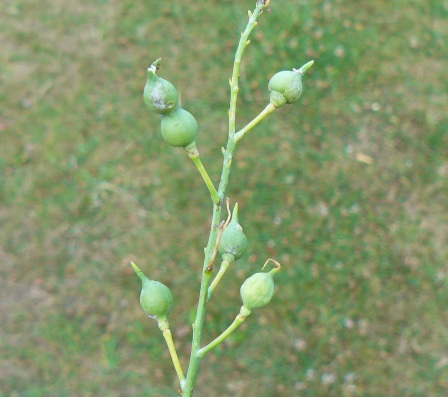
Other plants noted
included Harebells, Rest Harrow, Cat's-ear, Common
Ragwort, Yarrow, Viper's-bugloss, Common Knapweed,
Mugwort, Creeping Cinquefoil, Field Bindweed, Common
Mallow, Lesser Hawkbit.
Rest
Harrow on the left and Viper's Bugloss on the
right
Mystery
flies
I had replies
from Ralph Hollins and Tony Davis about the mystery
flies in last night's blog. Both are agreed that the
one on the left is a hoverfly named Long
Hoverfly - Sphaerophoria scripta.
For more information see . . . http://www.naturespot.org.uk/species/long-hoverfly.
This name jogged my memory and, looking back through
the records, I did in fact see one on Brook Meadow on
15-Sept last year.
The fly on the right
is not as straight forward. Tony thinks it is also a
hoverfly, but cannot identify it from the photo. Ralph
also goes for a hoverfly and hazards a guess that it
might be Leucozona lucorum which can be
found on page 204 of Chinery's Insect Guide. The
Nature Spot website gives more detail but the best
picture is at . . . http://www.diptera.info/forum/viewthread.php?thread_id=44781
Finally, Malcolm
Phillips thinks the right side fly is like one he
photographed recently while on holiday in Cuba. Well,
you never know!
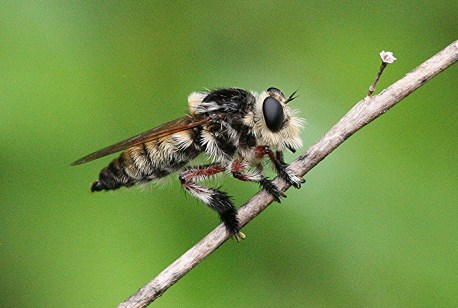
TUESDAY
JULY 21 - 2015
Brook
Meadow
Newly
flowering on the meadow site are Stone Parsley, Field
Bindweed, Red Bartsia, Perennial Sow-thistle and
Square-stalked St John's-wort.
The usual good growth of Strawberry Clover can
be seen along the edge of the path that goes round the
east side of the Lumley area. This area is favoured by
Strawberry Clover which likes the brackish influence
from the tidal Lumley Stream. Its flower heads are
much smaller than those of White Clover and Red
Clover, but the most distinctive feature of Strawberry
Clover, from which it gets its common name, is the
shape and colour of its fruiting heads. I found just
one rounded head today, though not yet with its pink
strawberry hue.
The Lumley area this
year is covered with Common Fleabane, some of
which already has its bright yellow flowers which
always make such a fine autumn show on Brook Meadow as
well as providing a good source of nectar for late
flying insects. The Sharp-flowered Rush which
has been very prominent on the Lumley area over the
past few years has really been pushed out and one has
to search around to find their flowering spikes.
The berries are ripening well on the Gwynne Johnson
Rowan plantation on the east side of the north
meadow, though most of the berries are still to turn
bright red.
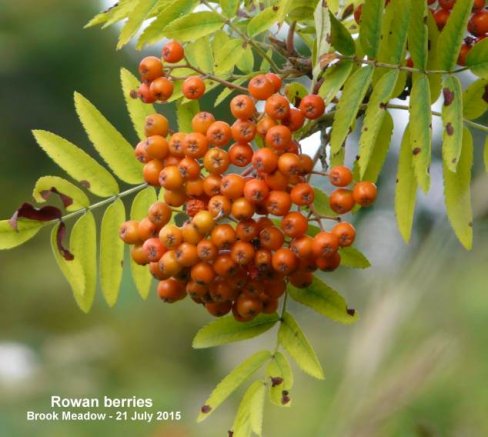
I also had two mystery
flies, very disticntly different. The one of the left
looks like a hoverfly but I can't identify it. The
other is furry and bee-like, but I am pretty sure it's
a fly. Any answers?
Malcolm Phillips has
put together the following collage of
butterflies that he has recently taken on Brook
Meadow. See if you can identify them. The two whites
may be tricky.
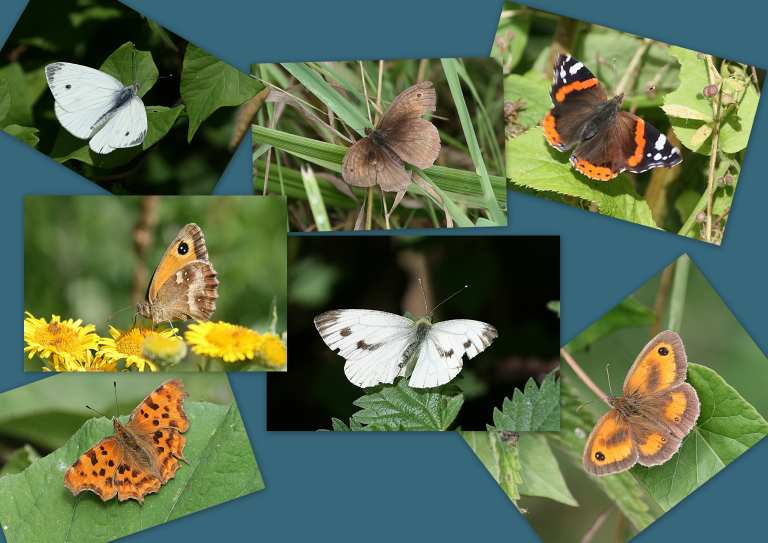
Warblington
shore
Peter
Milinets-Raby was out this morning for a walk along
the Warblington shore (6:06am to 8:53am - tide
falling). Swift 1 over the church (most possibly one
of the last I may see as they are leaving in droves
now?)
Conigar Point: 4 Greenshank (two with rings N//R+RY//-
and G//R+GO//- both fairly regular in the autumn
period, but not winter), 8 Redshank, Reed Warbler
singing from mini reed bed, Skylark singing over field
behind the point, 15 Mediterranean Gulls loafing (2
juvs, 1 adult winter and the rest still in summer), 1
Common Gull, 2 Common Tern.
Off Pook Lane: 50 Redshank, Mute Swan family (with 6
cygnets) out in the middle of the channel, Red
Breasted Merganser female, 1 Whimbrel, 1 Shelduck, 2
Common Tern, 7 Swallows and a family of three being
fed.

Horse Paddock: 13+
Goldfinch, Chiffchaff singing, 5 Swallows, 1
Treecreeper in oak tree in the paddock (the first I
have seen away from Brook Meadow).
Langstone Mill Pond: 38+ Little Egrets (See photo of
juv),
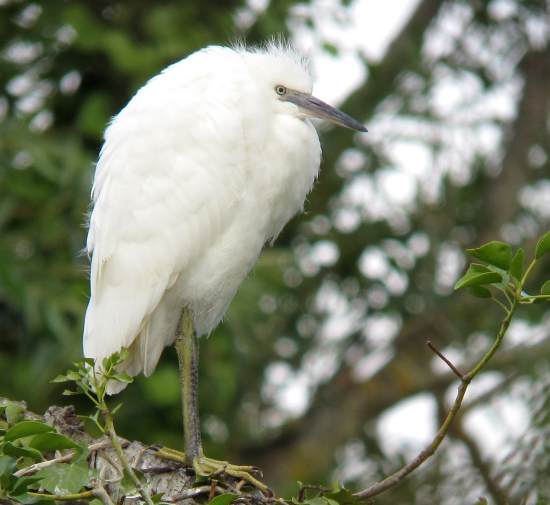
Cormorant roosting, 2
Reed Warbler still singing, Tufted Duck female with
two ducklings, AND, surprise, surprise the Grey Heron
pair that have a nest in the top of the Holm Oak have
a second brood of three fairly big young!
MONDAY
JULY 20 - 2015
Brook
Meadow
Malcolm
Phillips got an interesting insect on the meadow
today. As it has two wings not four, I assume it is a
fly, but which one? In fact, I recall seeing this big
chap a few days ago on the meadow feeding on Hogweed,
but it went before I could get a photo. Does anyone
know what it might be?
Ralph Hollins thinks it must be another example of
Volucella zonaria. Chinery's
illustration does not show the yellow band down the
front of the face but it is present in all the photos
Ralph has seen on the internet. This is a notorious
Hornet mimic, so don't be taken in by it.
Ralph's
news
Ralph Hollins
celebrated his 84th birthday last Saturday. Well done,
Ralph, I hope I can follow in your footsteps, though I
am still 5 years behind you. Yesterday (Sunday), he
cycled down to Thorney Great Deeps to see the Slender
Hare's Ear and Pointed Snails, but saw neither.
However, on the way he passed by Slipper Millpond
where the pair of Great Black-back Gulls were
perched forlornly on their raft with three Cormorants,
maybe praying for the return of their chicks which
drowned a few weeks ago.
Bats
on Hampshire Farm
Nik Knight and
David Search did a bat survey by walking around the
perimeter of the Hampshire Farm open space on the
evening of 9th July. From their recordings, Nik can
state that at least 6 species were present: Common
Pipistrelle, Soprano Pipistrelle, Serotine, Noctule
and two species from the genus Myotis. Myotis bats are
difficult to identify: ours were most likely to be
Natterer's or Bechstein's bats in the first instance
and Daubenton's or whiskered bats in the second
instance. Nik will enter these records in the
Hampshire database.
SUNDAY
JULY 19 - 2015
Railway
Wayside
The wayside to
the north of Emsworth Railway Station is currently a
blaze of colour with masses of wild flowers all along
the side of the ramp. It is a fantastic sight. Common
Ragwort, Wild Carrot, Common Fleabane, Common
Knapweed, Creeping Thistle and Spear Thistle are the
main contenders.
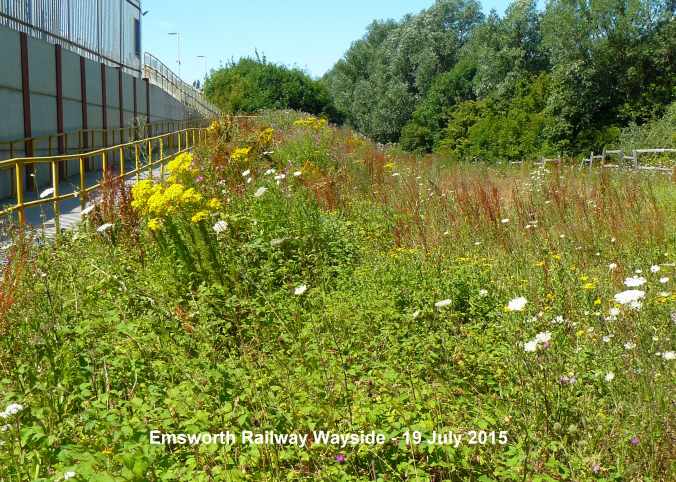
Marsh Woundwort flower
spikes are struggling for light through the mass of
competing vegetation and are less prominent than in
earlier years. I see the plants have been cut down
immediately inside the ramp. That is better than
spraying which happened last year. I found a good
display of bright pink flowers of Common
Centaury on the verge just outside the metal gate
on New Brighton Road.
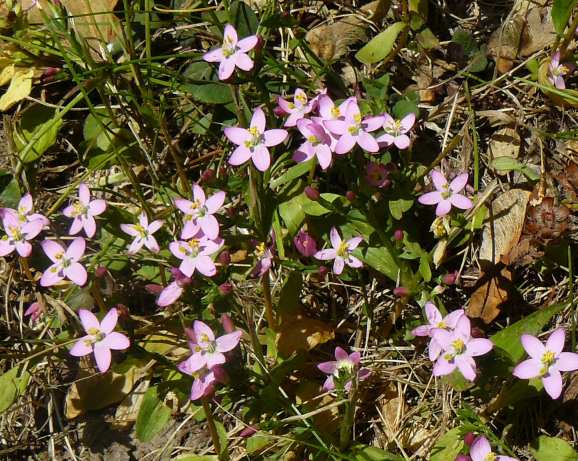
Just across the road,
a new driveway has been cut into the embankment, I
gather for access to a car park for vehicles involved
in repairing the rickety wall under the railway
bridge.
Monarchs
for sale
Ralph Hollins
comments in his wildlife diary about a recent surge of
sightings of Monarch butterflies in the Brighton area
which caused great excitement among Sussex butterfly
enthusiasts. That was, until someone made them aware
of the following website which advertises the supply
in the UK of Monarch butterflies at Weddings, Funerals
or other occasions. See . . http://www.butterflyconnections.co.uk/wedding_releases.html
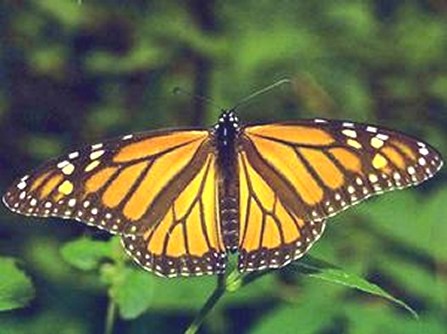
On this web site 30
live Monarchs will cost you a cool £260 (plus
packing and postage). Other butterflies for sale
include Swallowtails, Painted Ladies and Red Admirals.
The butterflies arrive in a box which needs to be kept
cool until the time of release. The site does add that
they only supply captive-bred butterflies. No
butterflies are taken from the wild. But how does one
tell the difference?
I recall this question coming up on this blog on June
20th concerning the origins of a Monarch butterfly
seen in Cosham, but the big question was did this
butterfly come across the Atlantic Ocean under its own
steam or was it one of the captive-bred insects.
Butterfly
kits
I should
admit, that I recently bought a butterfly kit for my
two locally-based grandchildren. These kits are quite
different from the adult butterflies that you can buy
from the above site. The butterflies (Painted Ladies,
in this case) arrive as caterpillars in a special
container in which they live for a while before
transforming themselves into chrysalis form. You then
transfer them to a supplied cage and wait 7-14 days
for the butterflies to emerge. They are released after
a few days, once their wings have developed fully. The
whole process is educational and the children (and I)
were fascinated to watch it. Apparently, these kits
are popular in schools too.
Mystery
plants
Chris Oakley
sent me a photos of a couple of strange plants from a
field at Bosham on the corner of Chequer Lane. Chris
says a couple of years ago travellers pitched there
for two weeks and when they were removed the owners
smothered it with herbicide killing off any growth and
then re-sowed it with a completely new crop. There are
two principal plants growing together, one is a bright
red, long-headed 'clover' and the other a very strange
tall blue flowered plant. Chris thinks they were
either for fodder or green manure but he can't find
any trace of such plants on the internet and wondered
if anyone knew what they were.
Well, I think I have
the answer to the Clover. It is Long-headed
Clover (Trifolium incarnatum ssp.
incarnatum). It is illustrated in
Blamey, Fitter and Fitter (p.153) and 'used to be
cultivated, but is now rarely seen' - except in
Bosham!
Ralph Hollins provided the answer to the other one -
Tansy-leaved Phacelia
(Phacelia-tanacetifolia) See the bottom
of page 210 of Fitter, Fitter and Blamey or go to
http://urbanpollinators.blogspot.co.uk/2012/12/phacelia-tanacetifolia-great-plant-for.html
Ralph says David Uren, farmer of Great Idsworth Farm,
planted a mass of it in his field behind Idsworth
Chapel in the years when he visited the farm weekly
but he do not know if it is still there.
Cuban
Cuckoos
Malcolm Phillips could
not find anything of special interest on Brook Meadow
today, so he thought I might like to see two Cuckoos
he saw in Cuba. Well, it makes a change from all these
boring flowers!
The largest and most colourful one is the Great Lizard
Cuckoo (on the left) and the second smaller one is the
Yellow-Billed Cuckoo (on the right).
SATURDAY
JULY 18 - 2015
Hollybank
Woods
I spent a
relaxing couple of hours out of the heat this
afternoon wandering around this beautiful woodland. In
fact, I almost had the woods to myself as I only met a
couple of people with dogs. Everyone must have gone to
the beach; They are welcome to it. The conservation
group are still busy building new hurdle gates and
more coppicing.
It was also very quiet from a wildlife point of view.
The only bird I heard singing was a Woodpigeon. As for
butterflies, I was hoping I might see White Admiral
and Silver-washed Fritillary, but there was no sign of
either of these summer regulars in Hollybank. Have
they been reported here this year I wonder?
Gatekeepers were everywhere along with a few Meadow
Browns, Speckled Woods, Large Whites and a
Peacock.
As for plants Enchanter's Nightshade lined the
edges of the path, its tall spikes having both white
flowers and fruits, which were covered in hooks,
presumably to aid in the dispersal of seeds.
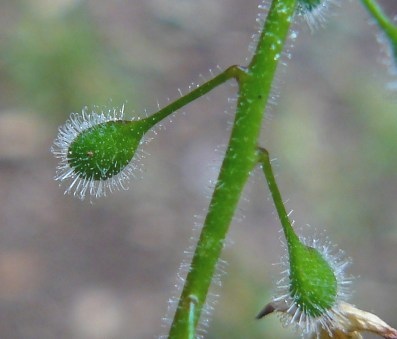
Marsh Thistle
was flowering in the open Jubilee area; I have only
recorded this before on Longcopse Hill. Just a few
Foxglove flowers were still open, most having gone
over. Other flowers noted included Wood Speedwell and
Yellow Pimpernel. Both pink- and white-flowered
Musk Mallow were out on the old Holly Lodge
clearing.
The paths were
liberally carpeted with Sweet Chestnut flower
spikes. Is this a good sign or a bad, I wonder?
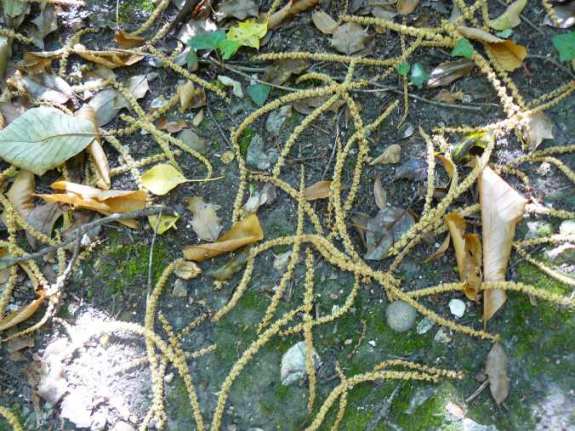
The dominant grass
throughout the woods was Common Bent. This
grass has open delicate panicles and short ligules, as
distinct from Creeping Bent which has long ligules.
There was no sign of any Creeping Bent though I did
not look hard for it. I also found several examples of
a very tall bent grass with long ligules which I
assume was Black Bent.
The usual woodland sedges were prominent along the
paths, particularly Remote Sedge and Wood Sedge, but I
could find no sign of the Dense-headed Heath Wood-rush
which Gwynne Johnson discovered here many years ago.
Brook
Meadow
Malcolm
Phillips did his daily tour round the meadow and got
this splendid photo of two Marbled Whites feeding
together on emerging Common Knapweed. Or maybe they
were preparing to mate? Getting one Marbled White is
hard enough, but getting two in one shot pretty
special.

Tortrix
moth
Our chief
entomological correspondent, Tony Davis wrote to
correct the identification of the small white moth
photographed by Chris Oakley on Hampshire Farm. Tony
said it is not a grass moth as suggested by Ralph
Hollins, but is a Tortrix moth called Eucosma
campoliliana. The larvae feed on the seeds and
stems of Common Ragwort. The moths fly in June and
July, from evening onwards, and are attracted to
light. Here is Chris's original photo.
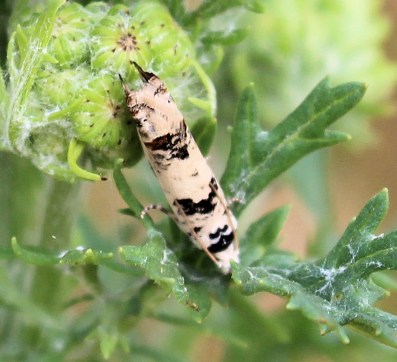
This moth is
distinctive with its black and brown markings on a
white background, and white head as shown in Chris's
photo. It is distributed widely over Britain, but
mainly coastally. It is fairly well distributed in
Hampshire, particularly on chalk downland and near the
coast, but very rarely recorded on the Isle of
Wight.
See . . . http://www.hantsmoths.org.uk/species/1197.php
Tortricidae is a family of moths, commonly known as
Tortrix moths or Leaf Roller moths. Most hold their
wings roof wise over the body at rest and many are
economically important pests, including the codling
moth, the larvae of which attacks apples.
Langstone
Mill Pond
Peter
Milinets-Raby popped down very briefly to Langstone
Mill Pond late morning just ahead of an incoming tide
(11am to 11:40am). The highlight was his first
Common Sandpiper running along the tidal creek
that leads to the mill.
Brian's Note: This bird will probably be a passage
migrant stopping off on its way from its breeding
grounds in the north to its wintering quarters in
Africa. We should be getting some in Emsworth too, so
please keep a look out. It is easy to identify from
its fluttery flight, its tail wagging and the white
sweep under the breast.

Other species of note
off shore were: 8 Greenshank, 3 Whimbrel. 77+ eclipse
plumaged Mallard being fed grain behind the mill - a
good count. No sign of the swan family.
FRIDAY
JULY 17 - 2015
We have had a tutorial
from Ralph Hollins today.
Grass
Moth?
First Ralph
says the 'tubular' moth that Chris Oakley photographed
on Hampshire Farm yesterday must be one of many
similar 'grass moths' that are currently on the wing.
They typically rest vertically on grasses, usually
head down, with wings wrapped tightly around the body.
Ralph thinks the moth is most likely to be
Crambus lathoniellus which is said to be
widespread and common in Hampshire. See . . .
http://www.hantsmoths.org.uk/species/1301.php

See
Correction to this moth ID on the following
day
Comb-footed
Spider
As to Chris
Oakley's spider with the big meal Ralph's thinks it is
a species of Comb-footed Spiders (family Theridiidae)
e.g. Enoplognatha ovata - one of our
commonest, prettiest and most recognizable species of
comb-footed spiders, found throughout the British
Isles and an occupant of most domestic gardens.
See . . . Figure 2 on . . http://wiki.britishspiders.org.uk/index.php5?title=Enoplognatha_ovata_latimana

Flying
Ants
Ralph Hollins
confirms Caroline French's report of flying ants
yesterday. He says, "I was going to mow my lawn in the
afternoon but as I went to get the mower out of the
shed I found myself in a 'snow storm' of insects
rising from the ground towards the masses of gulls
circling overhead. Looking down to the ground I found
every tuft of grass along the edge of the lawn where
it borders a concrete path (which must act as a roof
to the home of many ants) was a writhing black mass of
Black Garden Ants (see Chinery page 234). "
Silver
Y moth
Finally, Ralph
confirms the moth with the silver Greek letter 'Gamma'
its wing that was photographed on Brook Meadow by
Malcolm Phillips is in fact a Silver Y. See . . .
http://ukmoths.org.uk/show.php?bf=2441
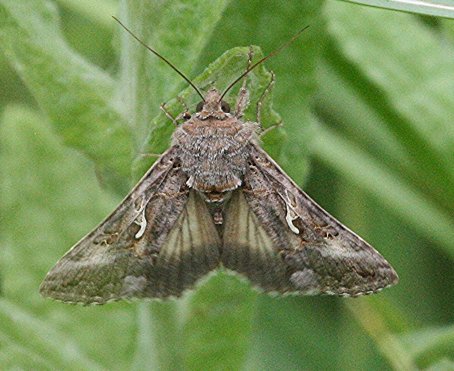
Holly
Blue
Peter
Milinets-Raby had a beautiful Holly Blue in his back
garden in Havant. He thinks it might be a male. Holly
Blues are very common in gardens, particularly where
there is Ivy growing. However, I have not tried sexing
them before. I think Peter is right about the sex of
this butterfly, as the female should have a broad
black margin to the wings.

For
earlier observations go to .
.
July
1-16